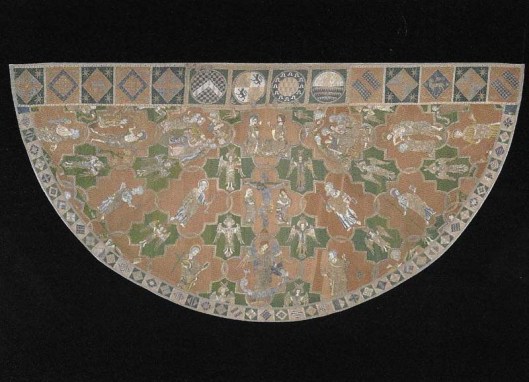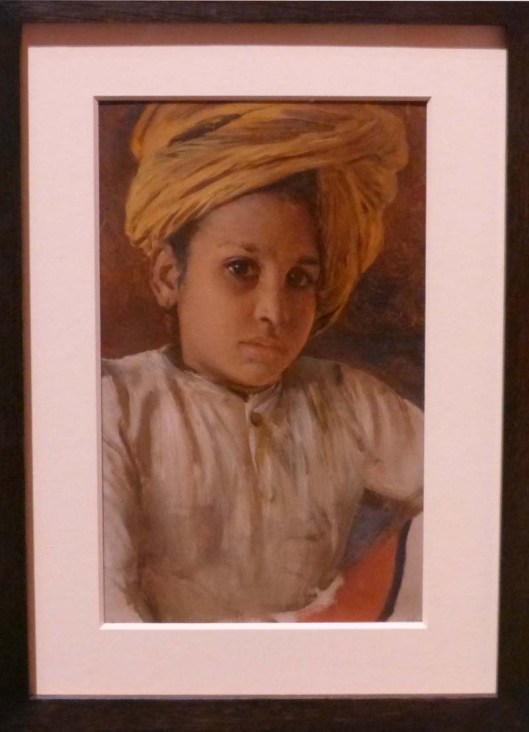Tags
Becket Casket, Clare Chasuble, Hyde Park Corner, Ismaili Centre, Jesse Cope, Joseph Nash, Knightsbridge, Lockwood Kipling, Mayo School of Art, No 14 bus, Opus Anglicanum, Piccadilly, Piccadilly Circus, Prosper Lafaye, PSPO, rhododendron, Rudolf Swoboda, Rudyard Kipling, Shaftesbury Avenue, Steeple Aston Cope, Suzuki Masaya, Syon Cope, Transport for London, V and A, Victoria and Albert Museum
Mediaeval embroidery and John Lockwood Kipling. Earlier this week I spent a couple of days in London, staying with my friend Mary, to catch three exhibitions before they closed, this Sunday. But the first astonishing exhibit was in Mary’s garden: a rhododendron bush in full bloom!
 My father’s favourite bus route when my parents lived in London was the number 14, because it passed so many places of interest. Over all the years since, it has remained the same, as far as I know. Certainly the small part we did, on the way to the Victoria and Albert Museum, gave me plenty of photo opps from the upstairs front seat, through the tinted window.
My father’s favourite bus route when my parents lived in London was the number 14, because it passed so many places of interest. Over all the years since, it has remained the same, as far as I know. Certainly the small part we did, on the way to the Victoria and Albert Museum, gave me plenty of photo opps from the upstairs front seat, through the tinted window.

Shaftesbury Avenue

Piccadilly Circus

Piccadilly

Hyde Park Corner

Knightsbridge. Better hoarding or the naked building works?
As for this, seen several times along Knightsbridge, we wondered if it was OK to drive anti-socially elsewhere. We considered this building virtually opposite the V and A, not particularly beautiful in the context of South Kensington, though when I went over later to see what it was – the Ismaili Centre – I could see that close up it had merit in many smaller architectural details.
We considered this building virtually opposite the V and A, not particularly beautiful in the context of South Kensington, though when I went over later to see what it was – the Ismaili Centre – I could see that close up it had merit in many smaller architectural details.
 The desire for coffee obliged us to walk across the central square of the museum.
The desire for coffee obliged us to walk across the central square of the museum.
Our principal target of the day was the exhibition, ‘Opus Anglicanum’, a style of English mediaeval embroidery which spread far into continental Europe. We were astounded by the intricacy of the work, and although we were able to discover who these embroiderers were, we could gain no insight as to just how long it took to create these masterpieces, especially as those commissioned e.g. for visits of foreign rulers, and for funerals will have had tight deadlines. The stitching was tiny in the extreme, and will have needed excellent light to execute. It was interesting to catch snatches of conversations of other visitors, some of whom clearly had specialist knowledge.
Photos were not allowed, so the following are scanned from postcards. Sadly it is not possible to see the individual stitching in them.

The Clare Chasuble

The Syon Cope

Detail from The Jesse Cope

Detail from The Steeple Aston Cope
Exhibits were not only of embroidery:

The Becket Casket
Having spent a good long time at this wonderful exhibition, we crossed the central square once more,
 and over lunch decided to visit another special exhibition in the Museum, (not in our original plan), that of work by, or inspired by, John Lockwood Kipling, father of Rudyard (whom his parents named after the village in Staffordshire where they had met.) Lockwood was a designer, illustrator (including of his son’s books) teacher, journalist and curator. Among other things he was an architectural sculptor to the South Kensington Museum, (now the V and A). He moved with his wife to become Director of the Mayo School of Art in Lahore. ‘His contribution to the impact of the British Empire on India’s artistic heritage is still recognised and debated today’.
and over lunch decided to visit another special exhibition in the Museum, (not in our original plan), that of work by, or inspired by, John Lockwood Kipling, father of Rudyard (whom his parents named after the village in Staffordshire where they had met.) Lockwood was a designer, illustrator (including of his son’s books) teacher, journalist and curator. Among other things he was an architectural sculptor to the South Kensington Museum, (now the V and A). He moved with his wife to become Director of the Mayo School of Art in Lahore. ‘His contribution to the impact of the British Empire on India’s artistic heritage is still recognised and debated today’.
These photos are mine.

Queen Victoria, Prince Albert and three of their children at the Indian Pavilion of the Great Exhibition, by Prosper Lafaye

The Great Exhibition: India No 4, by Joseph Nash

Pearlware jug, decorated by Lockwood Kipling

These nineteenth century saddle cloths had embroidery every bit as rich and intricate as we had seen in the morning

Student at the Mayo School, by Rudolf Swoboda

Rudyard Kipling illustrating his own stories

Lockwood Kipling for his grandchildren
This next picture was I think my favourite exhibit. I just loved how the reflected harsh Indian light had enabled the colourful details on the near, shaded, side to be picked out.

A Peep at the Train by Rudolf Swoboda
Then as we returned again to the tearoom for final refreshment before making the journey back to Mary’s place, I couldn’t resist taking a photo of this in the Japanese section as we went through it.

Sprouting Box, by Suzuki Masaya, 1978, in acrylic

Teatime
Two concluding exhibitions the next day…

A most enjoyable journey on the 14 bus and a good look at some very interesting exhibits, thank you for sharing them.
LikeLike
Some day I must do the part of the route further to the west, which my father also enjoyed. I think the fact that it went (still does) past Chelsea football Ground – he was a great supporter – had something to do with it!
LikeLike
I have never been further than the V&A myself.
LikeLiked by 1 person
☺
LikeLike
A very fine record of our interesting bus ride and visit -it was good to be reminded of so many of the things we saw that day.
LikeLike
Thank you for sharing the experience!
LikeLike
Wonderful pictures – and well done you on sharing so many fascinating details with us. My usual bus is the 74 and I’m always a bit disappointed if I don’t get the front seat on top. xx
LikeLike
Just a little unnerving when you feel you’re only a nose-length away from the bus in front at a stop!
LikeLike
Lovely post. The saddle cloth is beautiful!
LikeLike
It was uncanny after the mediaeval embroidery of the morning.
LikeLike
That looks like a top quality day.
LikeLike
With another to follow…
LikeLiked by 1 person
This was a quality day, and thank you for sharing it with us. I like the no anti-social driving sign, and wouldn’t mind seeing a few of those around where I live.
The rhododendron is beautiful. It must be relatively warm there in London this winter.
LikeLike
I wonder who judges whether driving is antisocial?
LikeLike
Wonderful artwork and lovely reflections. Thanks for this discovery of an other Kipling !
LikeLike
Not to mention the Kipling who makes the cakes!
LikeLike
That’s another discovery. I’m more familiar with Biscuits Brossard !
LikeLike
Of which I have never heard! And I should have said ‘Mr’ Kipling, who, according to his tagline, ‘makes exceedingly good cakes’.
LikeLike
As always, very interesting! Sprouting box? For sprouting beans etc?
LikeLike
I assumed so, but perhaps there’s a degree of artistic licence!
LikeLike